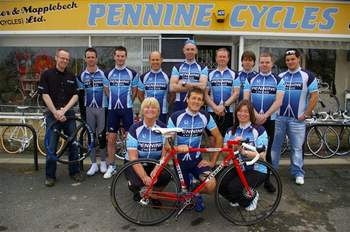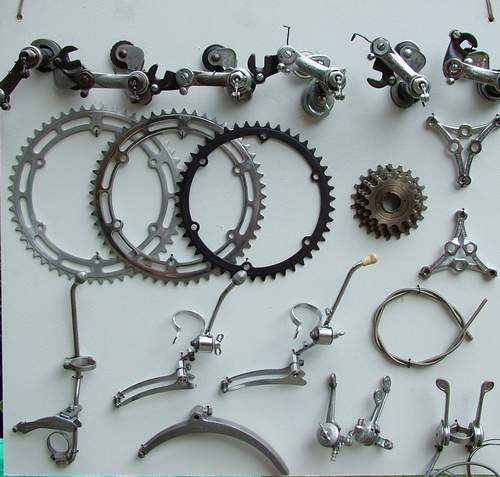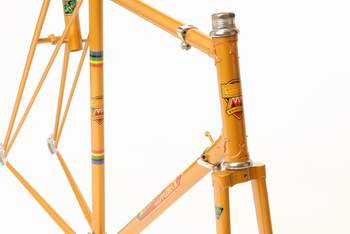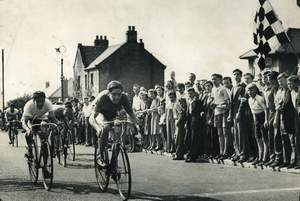Vol. 2, Issue 4 - Jul / Aug 2006
Posted: Tuesday 25th July 2006
Lightweight News is the newsletter for the Lightweight group which is a specialist group within the Veteran-Cycle Club which also publishes a bi-monthly magazine, News and Views plus four copies of The Boneshaker each year.
In L N 3, I confessed to ‘jumping’ lorries in the 50s for protection against a head wind. I recently met reader Gordon Barnes at his holiday home in France. He tells me of the time when he did just this; listened to the lorry trundle by and then slipped in nice and tight to the tailboard. Great he thought until he noticed that he was riding next to a tow bar and realised that he was squeezed in between the lorry and its trailer! Gordon used to ride with us in Cambridge on a regular basis but has recently moved to France where he has a farmhouse plus two gites and a studio accommodation within the house. He is a short distance from Bergerac and the cycling in the area is absolutely stunning. Beautiful undulating countryside and probably an average of 3 – 4 cars per hour. Even they are extremely considerate and pull well to one side to let you pass. He has a website at: www.frenchoasisholidays.com/ and Gordon and Jane do everything possible to make your stay a joy – highly recommended.
I also casually mentioned another 50s phenomenon, classification of things cycling as ‘gen’ or ‘un/non gen’. I was surprised at the amount of feedback on this item. Typical was a piece from Paul Curtis along the lines of:
I remember when as a young lad of 14 years in 1959 I joined Crawley CC. Like many young lads I thought that my brand new Lincoln Imp would be the ‘bees knees’.
How wrong I was. In no time I had taken off the Benelux 5-speed changer, rear GB brake, mudguards and plastic pump. I converted it to 69” fixed-wheel and fitted an Apex Gran Prix pump beneath the bottom bracket with Terry spring clips. Having sorted out the bike Paul acquired the ‘compulsory’ bonk-bag made with striped deckchair material plus a Walls Ice Cream cape and tub roll. Front lamps had to go on a bracket mounted beneath the nut on the front axle or on a clip on the front bars. Paul’s favourite snack at the cafe stop was a Lyons boxed fruit pie at 6d (2½np). He says that big woolly jumpers were worn in the winter. He also had a Miller dynamo and remembers that his feet were always freezing (pre-clipless pedals and neoprene booties of course).
Whitaker and Mapplebeck/Pennine Cycles
Back in the late 40s and early 50s I mis-spent most of my youth riding a bike, usually along with a couple of good friends, we were all members of King’s Lynn Cycling Club. One of the musketeers was Colin (Dickie) Lines who lived in nearby Dersingham and was an apprenticed engineer with Dodman’s Engineering.
Although we were all ‘Union’ riders our hearts were really in the more glamorous road racing scene. However there was no chance to do it at that time and place so we spent most of our time time-trialling under the auspices of the NCU, within the Fenland RRA, whilst fantasising about life as a continental road racer.
In no time at all Dickie fell for the stylish machines produced by Whitaker and Mapplebeck in Bradford and soon ended up owning first a Nidderdale in 1950 which was a middle of the range machine. In 1952 however he purchased the top-of-the-range Scelta dei Campioni (The Choice of Champions) which was his pride and joy. Unfortunately the S de Campioni was later written off in a road accident although the Nidderdale is still owned by a mutual friend of ours. Colin remembers the S dei C as having Nervex Professional lugs (see 1947 specification below), 74º head and 72º seat angles. He had it built with a twin-plate fork crown and round forks, finished in Ivory (no chrome) with red and blue double-box lining.
In 1946 Geoff Whitaker and Johnny Mapplebeck were both demobbed from the army having been friends before the war. On 7th July they set up in the business of frame building along with a retail cycle shop catering for the lightweight rider – by 1947 the frame production was up and running (see note below from Ken Russell). Having spent some of their time in the forces serving in Italy, the Italian influence could be seen straight away in the style, structure, finish and names of the machines they were to build. They were based at Ingleby Road in Bradford and soon started to build an impressive range of cycles down in the cellar. All of the staff here were keen and committed cyclists which I think was the case at many of the small manufacturers in those days.
During this period 1948 – 52 Ken Russell worked in the shop as well as racing very successfully for Whitaker & Mapplebeck. In 1952 Geoff Whitaker was to leave the business to work in Bristol and Geoff Wood who owned the Pennine Accessory Company (manufacturing C.O.2 pumps, etc.) came into the company bringing the Pennine name. During the next 12 months the name of Whitaker and Mapplebeck was phased out and frames were, and are still, made under the name of Pennine until this day.
I have a copy of the W & M brochure, said to be March 1949, (the cover has an action picture taken from the 1948 Burbage Road Race). The machines listed are:
Scelta dei Campioni, “The finest racing cycle built, incorporating a specification of the best British and Continental components, which make a machine worthy of a champion.” – Frame price £15-15-0
Nidderdale, “Popular choice.” – Frame price £12.12.0
Ingleby, “For those who prefer the welded frame.” – Frame price £11.11.0
Re Della Corsa, (King of the Race), “All its name implies!” Frame price £13-19-6
Weights, where mentioned were:
S dei C complete machine with gears, etc – 21 lbs. R della C – frame only – 6 ½ lbs.
As you can see from the specification below, they obviously chose components with the idea of keeping the weight down to what was a very respectable level in those days.
The catalogue describes all models as road racing machines but says that they could also be supplied as pure track machines. They would similarly build touring machines to order.
The suggested specification for the S dei Campioni was:- Frame: Superbe hand-cut and filed lugs to our own special design, Reynolds 531 Butted Tubing, Lytaloy Head fittings and head-clip, 73º head, 71º seat, 22½” top tube, 2⅝” fork rake, 40½” wheelbase; or to customers own requirements. Size to order. Wheels:- Weinmann Scherens hollow 27” sprint rims, Gnutti alloy hubs, Inciclo Vittoria tubulars, GB alloy wingnuts. Pump:- Bluemels Tour-de-France 18”. Saddle:- Brooks B17. Brakes:- Bulla alloy. Pedals:- Lyotard alloy Chainwheel and cranks:- Allez Chain: ½” x 3/32” Gear:- Huret, Osgear or Simplex 4-speed with Eureka freewheel Bars:- Strata stem and bars (shape to choice) Finish:- Multi-colour shaded with contrasting head-tube and panel on seat–tube, lugs lined and double box-lining. Colours to choice. Price £46-13-3 (or with Durax cranks and Simplex double-chainring and changer £49-19-6).
The specification of the finish on these machines demonstrates the Continental influence and shows that W & M were building with ‘League’ riders in mind rather than the more staid ‘Union’ time-triallists who would at this time be clad in black from head to toe – so as to be inconspicuous!
Later in 1960 Pennine listed an Italia frame with the seat stays welded direct to the seat lug. Equipped with 5-speed gear and sprints and tubs this machine turned the scales at 19lbs. There was also a Grand Primo frame set with the ubiquitous Nervex Professional lugs and Campag ends. The Re Della Corsa by now was built with Italian style plain lugs and Campag ends with 72º head and 73º seat tube which gave a slightly shorter top-tube.
Pennine were also marketing the Richmond frame with 72º parallel angles, 531 tubing with “elaborately cut Prugnat lugs and Benelux, Agrati or Campag (extra cost) ends”. To complete their range at this time the Nidderdale was produced using Legere lugs and the bottom-of-the-range Marilyn which was only sold as a built-up machine.
Patricia, my wife, has a 1964 Pennine Richmond 19” road frame; No 64041 (64041 – 64 denotes year – 041 shows it was 41st built that year). This has the 72 x 72º angles, with 21” top tube; 16 ¾” chainstays; braze-on cable eyes under top tube, pump pegs (19”) on down tube and a fork lamp boss; Agrati front and rear ends; Red with white bands:- 6 ½” on the seat tube and 5 ½” on the down tube, a replica of the original finish. The Reynolds 531 butted tubing has Prugnat lugs. In 1960 the Richmond frame set cost £13 15s. but Campagnolo ends were 15s. extra. Patricia’s frame has the decorated seat-stay tops with artwork depicting an Alpine scene. This work was done on selected frames by Johnny’s wife May until sadly she died. We have traced, via the ‘Wool Jersey’ website, several frames with variations of this decoration, some in the U.S.A.
Another strand in the W & M/Pennine story concerns the Baines Flying Gate. One story is that Bill Baines had decided to drop production of the Gate in the 50s when he received an order for six frames from the States. He had tubing left in stock but not the facilities to build them up so he sent the tubes to W & M/Pennine who built the frames for him. These frames will have left-hand lamp bosses. It could be that some tubes were left over and they were also built up as W & M frames. Peter Lowry owns one of them, believed to be 1954.
Johnny Mapleback was to continue working until he was 80 years of age when he retired during February 2000 to live and carry on cycling in Canada – he was 87 in May this year. Paul Corcoran who had worked full-time in the company since 1991, and prior to that part-time, took over the business from Johnny when he retired. He was managing the business in 1995 when they moved premises from Ingleby Road to 1019 Thornton Road, Bradford, West Yorkshire, telephone 01274 881030 – 1 mile up the road from the old shop.

Graham Saunders continues to build custom-built framesets and execute frame repairs on the premises, having worked for the company for over forty years, some of them alongside Johnny Mapplebeck, who presumably taught him his frame-building skills. To this day Whitaker & Mapplebeck (Cycles) Limited trading as Pennine Cycles is owned by Paul and his wife, Sandra, operating as an independent bicycle dealer still making custom-built lightweight steel framesets for the racing man and providing a quality professional service for the rider. This year Pennine Cycles will be celebrating sixty years in the business.
The following note was sent to me by Ken Russell a few days ago: “The photo of me at the finish of the “Burbage R.R” 1947 shows me riding the very first W&M that was built during Spring / Summer 1947. Both Geoff & Johnny (and myself) were involved in the making of this. I won my first Road Race on it’s first outing, the “Shropshire Hospital’s RR” 3rd & Jnr’s.( August 1947)?. The catalogue you have mentioned shows a rider who was my closest friend until his death in 1990. His name, W.(Bill) Sugden and he won the Burbage RR in 1948. I have just put the phone down after speaking to Johnny for almost an hour !!!”
Cycle Jumbles by David Palk:
If Ebay is the Big Mac of any trading interest amongst us then cycle jumbles must be the home-cooked Sunday roast (nut roast for me). Face-to-face trading is so much more pleasant, wholesome and satisfying! As someone who does not use a computer at home and has no credit card, Ebay is of no interest at all. It seems improbable that cycle jumbles can continue to flourish in the presence of Ebay but the big jumbles seem to have gone from strength to strength over the last few years. I have yet to visit any jumble without coming away with at least one or two interesting, exciting or necessary acquisitions – usually for peanuts. The regular Ripley Jumbles (V-CC, April and October, Charlotteville CC, July) are certainly the best I have been to. I have never counted, but the V-CC Ripley jumbles must currently attract well over a hundred vendors.
Cycle jumbles are a chance to discover, buy, sell, learn and socialise, all at the same time – a real Mecca for old bike enthusiasts. The picturesque Surrey village location adds a further dimension. I did my first in ’93, and have been hopelessly addicted ever since. There are a few other large jumbles around the country and also many smaller ones organised by cycling clubs and local CTC groups. Every jumble is a source of bargain bits, hard to find items and, potentially, unrepeatable treasure.
Cycle jumbles should be of interest to every lightweight-cycle enthusiast. The Ripley jumbles always include a good selection of the type of equipment which excites Lightweight Group followers. You never know what you might stumble across, which is a vital part of the draw for me. Every jumble provides fuel to fire my curious fascination with old performance bicycles. The social side is just as important. Exciting finds and tales of interesting deals can be compared amongst friends old and new. At the pub afterwards, much as with fishing, there is often a story of the one that got away. Check the classifieds in Cycling Weekly for notice of the larger jumbles and keep an ear to the ground for news of the smaller local ones. Jumbles have been a mainstay of my hobby over the last decade or so and have allowed me to enjoy ownership of some beautiful and interesting things – all on an absolute shoestring budget. I sincerely hope that they remain well supported and that as many fellow enthusiasts as possible can continue to enjoy them as much as I do. I am truly in my element at a cycle jumble!
Ten hints and tips for successful jumbling – from a seasoned Ripley campaigner:
- Go as a trader. Sell your odds and pay for the trip. The best stuff changes hands between the traders, well before the gates open to ‘punters’. It’s the early bird that catches the worm!
- Book early. Indoor pitches are often oversubscribed months in advance.
- Don’t set up to sell until you’ve done your buying. 7-9 is hunting time! You’ve then got until lunchtime to relax, socialise and sell at your leisure.
- Take a tape measure, straight edge, tools, wet-wipes (for your oily hands) and plenty of change.
- Don’t be shy – haggle hard. As a vendor I expect and enjoy some intense bartering!
- CAVEAT EMPTOR! Check any item for prospective purchase very, very carefully.
- Trawl for bargains towards the end. I’ve had some great things, very cheaply, at packing-up time.
- Don’t hesitate. Someone else is sure to buy that desirable item if you don’t.
- Don’t go with a profiteering attitude. It’s supposed to be enjoyment amongst fellow enthusiasts.
- Socialise and have fun. I’ll see you in The Anchor for lunch and a pint afterwards.
There go all the trade secrets!

Just before we left for a cycling holiday in Italy we went to the Herne Hill track day where the Lightweight Group represented by the Hampshire section put on a superb display of classic lightweight machines. Also on display was this board showing all the desirable goodies produced by Simplex in the 40s and 50s. The board was assembled by Tony Beckett (Campag Marque Enthusiast – wash your mouth out Tony!). See if you can identify everything on the board – answers at end of L News.
A few weeks before Herne Hill Patricia and I went to Reading for Terry Pearce’s Lightweight Ride. Up to now Terry has had a hot line to the weather-man and been able to arrange great weather for this event – it seems he forgot to send him a bottle of whisky for his pains last year as the ride started in gentle rain and it progressed to torrential downpour for the ride back after the lunch stop. In spite of this were are glad we went. The turnout was, I think, a bit down this year but all the usual mad diehards were there.
I took my 1953 Flying Scot Continental and Patricia took her 1951 Ephgrave No. 1 (on sprints, how glad we were to get back without a puncture – neither of us dared to mention the subject as we ploughed along on roads with rivers of water, gravel and flints running down them). Apart from this the event was what we have grown to expect from Terry so a good day was had by all.
The week after was the Neville Ireland Memorial Ride for Paris and Rensch which we organised here at Cambridge. We had a grand turnout of 29 including eight Galibiers, six Tour de France and three Rensch plus several other classics. Eight of Neville’s family joined us for dinner and I think it is safe to say that all on the ride enjoyed every minute of it judging by their reluctance to leave at the end. Dennis Talbot, a Hercules pro-rider from the 50s joined us as did Martin and Irene from the Cambridge/Venice Section. Martin (Hanczyc) used to be a regular in the New England Section rides before moving to Italy.
The following weekend we went to Hampshire for the South Downs Ride. I took my 1958 Cinelli Corsa with Campag gears and bar-end levers and Patricia took her Ephgrave to show the boys down South. Knowing the topography of the area we made sure that we had reasonable gears and had a great time with the Hampshire Group even surviving a John Spooner ‘going-over’ of our bikes at lunchtime – they went through with flying colours apart from one cotter pin having two extra threads showing than its partner. It seems the maximum tolerance is one.
Notes from Mick Madgett:
I’ve managed to arrange a special order of stainless 15g butted spokes (The Spokes are 1.8 / 1.6mm, so are 15/16.5g) in lengths suitable for 27×1¼ wheels (ie 11¾” to 12 1/8″). They should be with me by now. (It’s taken since before Christmas to get hold of them!)
Also, anyone going to the L’Eroica who wishes to can contact me in regards to either sharing travel/accomodation, or just meeting up over there.
Mick’s email is: MADGETTSCYCLES@aol.com Telephone during working hours: 01379 650419
Ed: this is really good news as spokes for rebuilding wheels which look good in 50s bikes are a problem. Mick also has stocks of 26 and 27” tyres. I can especially recommend the Panaracers, if only I could come up with a way of deleting the logos which are rather bright.
Contact Bill Squirrell, John Lattimore or Les Bowerman (phone nos. as V-CC yearbook) for more details of cycle jumbles at Ripley.
Tony Beckett’s Simplex board –answers:
The items are top row: 1949 TdeF gear; early 50’s alloy armed TdeF gear; 1950 JUY50 gear; 1951 TdeF De Lux twin cable gear; mid 50’s TdeF gear; late 50’s TdeF gear.
Middle row; Outer chainrings in aluminium and chromed steel; inner ring in blackened steel; 4sp freewheel; flat and off-set chainring adaptors.
Bottom row; c1949 TdeF front changer; early 50’s Competition front changer; late 50’s Competition front changer; length of genuine Simplex cable; c1952 cage/chainguard for Competition front changer; gear levers – single RH lever; double RH lever; double R&L lever.
Apology from the editor: the article on Dave Keeler has been held over until the next issue due to pressure of space and some last minute research.
Posted: Tuesday 25th July 2006
This article appears in the following categories.
Upcoming Events
Whether you are looking for a gentle social meet up, or a 100-mile ride browse the community’s upcoming events and plan your next weekend outing.



